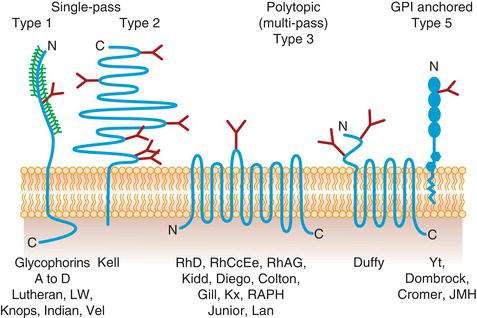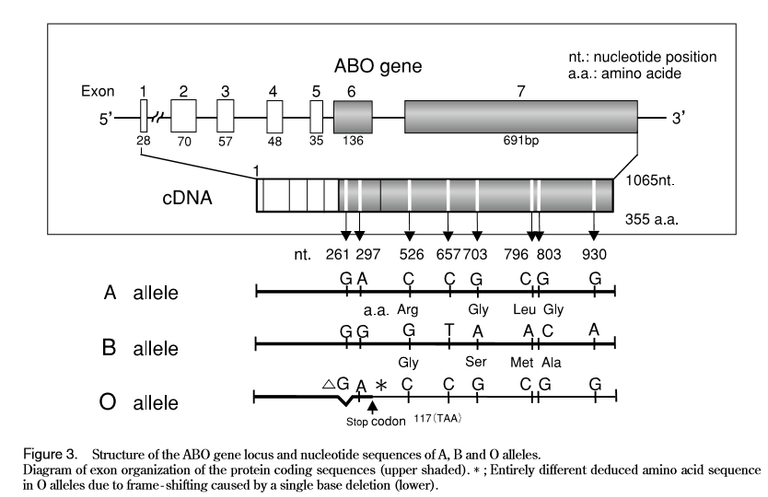Hello Steemians, Happy Boxing Day to you all. This post is a continuation of the series why we have different blood groups which started from here. We had earlier established that the history of blood revealed some factors were the cause of agglutination experienced during a blood transfusion. We also concluded that these factors are what translate into the various blood groups we know. These factors are called antigens and antibodies. But first and foremost we will be treating antigens.
Our primary objective is to explain/answer the following:
- Define and Describe Antigens.
- Explain the structure of Antigens.
- Identify the various enzymes that catalyze the synthesis of the antigens.
- Identify the multiple reasons that cause variance in blood group antigens in structure, size, chemical composition, and genes.
What are Antigens?
Yes, you are right; they are antibodies (anti) generators (gen).
Antigens are molecules that are capable of binding to correlating molecules (antibodies) produced by the immune system as an immune response via chemical linkages. They also induce an immune response by activating the lymphocytes (the fighting type of the white blood cells). They could either be endogenous (foreign) antigens or endogenous (self) antigens. They are usually macromolecules, i.e., polysaccharides, peptides or lipids.
Do you know what Immunogen is? Or is it the same as antigen
Antigens and Immunogen have been used mutually, but there is a little yet the clear difference between the two words. An Immunogen is a type of antigen that can bind to an antibody and also induce an immune response whereas an antigen can only link to an antibody but can't induce an immune response, i.e., all immunogens are antigens, but not all antigens are immunogens. Example of such molecule that fulfills the illustration is the small molecule called Hapten which is antigenic but not immunogenic. However, antigens can be made to have immunogenic property (Immunogenicity) by attaching them to carrier molecules like Ovalbumin and KLH (Keyhole Limpet Hemocyanin) that are capable of eliciting the immune response.
Immunogenicity is the ability or characteristics of an antigen to induce an immune response. These depend on the size (an antigen with kilo Dalton of less than 20kDa or ~200 amino acids will not be immunogenic), chemical structure (proteins are more immunogenic than polysaccharides and lipids), epitope density, and foreignness (only foreign molecules can stimulate an immune response) of antigen. It should be noted that blood group antigens are immunogenic with ABO being the most immunogenic, thus will be discussed mainly in this post.

The Red Cell Membrane carries the blood group antigens which are integrated into it in a specific way on it. Some cross the membrane once and possess cytoplasmic C-terminal domain and an external N-terminal domain – Type 1, The Kell blood group antigen possesses an internal N-terminus and an external C-terminus – Type 2. Some pass through the membrane several times, i.e., polytopic- Type 3 with both termini being cytoplasmic, Type 4 is cytoplasmic but not present in red blood cells. Type 5 does not pass through the membrane but are anchored to the membrane with the aid of lipid tail (glycosylphosphatidylinositol or GPI anchor) due to them not possessing a membrane-spanning domain.
The ABO antigens are examples of the carbohydrates (oligosaccharides). Their oligosaccharide chains combine with either polypeptide or ceramide to form glycoproteins or glycosphingolipids respectively.
The glycan part of the glycoprotein is divided into two classes N-glycans, highly branched structures attached to the residues of asparagine of the amino acid and O-glycans, smaller and connected to the hydroxyl oxygen of serine or threonine residues. The two are assigned through N-acetylgalactosamine to their residues. The glycosphingolipids could either be lacto-, globo- or ganglio-series and this is also based on the carbohydrate chain.
DIFFERENCE IN STRUCTURES
H Antigen
The expression of the ABO blood antigens is dependent on the H gene and the ABO gene because the H antigen is a precursor to the ABO antigens. It is a foundation for the ABO blood antigens. Although the two genes are related, they are different blood group systems because the loci of the genes are not associated.
The H antigen is also a carbohydrate antigen. It should be noted that the process of formation of oligosaccharide from monosaccharide is catalyzed by glycosyltransferase which is encoded by the specific blood group gene which differs across different blood group antigens. This glycosyltransferase catalyzes the addition of a monosaccharide from its nucleotide donor to the precursor disaccharide (carbohydrate determinants) at the non-reducing end. The glycosyltransferase like every other enzyme is specific in action thus leading to the antigen specificities.
Six types of the precursor disaccharide exist, and they include:
- Type 1: Galβ1→3GlcNAcβ1-R
- Type 2: Galβ1→4GlcNAcβ1-R
- Type 3: Galβ1→3GalNAcα1-R
- Type 4: Galβ1→3GalNAcβ1-R
- Type 5: Galβ1→3Galβ1-R
- Type 6: Galβ1→4Glcβ1-R
Type 1 and Type 2 are the main precursor disaccharide and present in secretions and tissues and on red blood cells respectively.
The gene responsible for H antigen on the red blood cell is the FUT1 whose chromosomal location is 19q13.33. The genes encode a glycosyltransferase known as the α1, 2-fucosyltransferase (H-transferase); which catalyze the addition of L-fucose from a guanosine diphosphate (GDP)-L-fucose donor to of one of the precursor acceptors shown above at the α→12 linkage on terminal galactose.
Another type of the H antigen gene is the FUT2 (Se Locus) which synthesized the production of the H antigen in saliva and bodily secretions. The synthesis is catalyzed by a different kind of α1, 2-fucosyltransferase known as the Secretor-transferase. Numerous researchers have established that FUT1 gene prefers the Type 2 acceptor substrate while the FUT2 gene prefers the Type 1 acceptor substrate.
.png)
A blood group
The A gene encodes α1, 3-N-acetyl-ᴅ-galactosaminyltransferase or A transferase which catalyzes the transfer of N-acetyl-ᴅ-galactosamine from a uridine diphosphate (UDP)-N-acetylgalactosamine donor in a α1→3 linkage on terminal Gal of H antigen.
B blood group
The B gene encodes α1, 3- ᴅ -galactosyltransferase, transfers ᴅ-galactose from UDP-galactose to the fucosylated galactose of H.
The AB blood group is a combination of the two A and B gene.
O blood group
O allele encodes a glycosyltransferase (O transferase) which has no function (i.e., does not produce either A or B antigen) but leaves H antigen as the only ABO structure present in blood type.
Readers can watch this video lecture on Glycosyltransferase and the ABO blood group by AK Lectures.
https://m.youtube.com/watch?v=YSVbO2sHlBE
Cause of differences in enzymes
It should be noted that the A, B, and O allele have seven nucleotide substitutions, of which four translate into various amino acid substitutions (G268A, R176G, G235S and L266M) which determine the distinction of the different gene products (glycosyltransferase). The production of an enzyme with no function in the O allele is due to the deletion of guanine at position 261 which instigates a frame-shift thus leading to loss of transferase activity.
.png)
Subgroups – An Indication of differences in antigens
Qualitative Differences
- There exist subgroups within the A blood group. A1 and A2 are classified as the primary subgroups of the A blood group system. However, A3, Ax, Aend, Am, and Ael are subgroups which have observed under the A blood groups and are collectively referred to as weaker A do not have much clinical significance. Among the weaker A, the A antigen sites progressively decrease. However, the weakness of the A antigen in these blood groups does not stop them from causing agglutination to a stronger A blood group.
- Within the B blood group also exists various blood groups which are based on the quantity of B antigen. They include B1, B3, Bx, Bm and Bel and the B antigen decrease across in that order.
Qualitative differences
- The AB blood group is not left out as it contains nine subgroups (AxB, A1Bx, AmB, A1Bm, AelB, A1Bel, cisA2B3, cisA2B, and cisA1B3). Emphasis will be placed on the cis-AB group due to their importance to clinical science. The cisAB blood group is a scare blood group with three types; cisA2B3 (A2B3/O), cisA2B (A2B3/B) and cisA1B3 (A2B3/A1). Ideally, the AB blood group antigen is produced when the AB blood group has one A allele and B allele on the chromosome, i.e., offspring inherit one gene from an individual parent. But the reverse is the case with the cisAB as the A and B gene are inherited as the same gene. Research shows that the first two cisA2B3 are identical but different from the cisA1B3 by two nucleotide substitution which translates to amino acid substitutions.
- The H deficient blood group (Bombay blood group) is as a result of a mutant FUT1 gene (h) resulting in inactive gene products.
ABO blood antigens are also referred to as Isoantigens, i.e., they are limited to a species, and each one of them stimulates the production of a correlating antibody in individuals that lack it, i.e., isoimmunity which also explains the variance in the blood antigens.
In summary, differences such as specificity of gene products (glycosyltransferase) and gene mutations, deletions and, isoimmunity and antigenicity strength are responsible for different antigens.
REFERENCES
Images not referenced are from the two textbooks below
- Book: Blood Group Antigen Facts Book by Reid M.E. and Lomas-Francis C.
- Book: Human Blood Groups by Daniel G.
- Blood Groups and Red Cell Antigens by Dean L. Internet
- Biological and clinical aspects of ABO blood group system: A Review of Serology, biochemistry and genetic characteristics, and clinical application of ABO antigens.J.Med.Invest.55:174-182, August 2008 by Eiji Hosoi. Online at Semantic Scholars
- YouTube: Glycosyltransferase and ABO blood groups by AK Lectures
- Wikipedia
Thank you for reading my content !!. Stay tuned for the continuation of the series on Antibodies, Genetics of Blood Groups and Evolutionary theory of blood groups.
If you are interested in the various aspect of Science, Technology, Engineering and Mathematics , join the best science project on steemit @steemstem to view high-quality science post. You can join us at steemit.chat to interact and have excellent discussions with science authors in the steemit community.
Thanks to @foundation for the steemstem gif


I really enjoyed this (like you have no idea)
I still remember in my bio class when we learned about blood groups and talked about the sugars but we had never gone this indepth. Like this is absolutely awesome! Thank you for sharing
Yea you are right
This is why i actually blog about it, to make people understand
Thanks for reading
Intersting :-/ Im A plus btw :/
Intersting post 👍
Thank you for sharing a group of pictures about a group of blood, describing us with a nice picture and sharing it I learned a lot about your post. I found a lot of fun about your blood group after learning about your post and I am thankful to many of you for giving me so much important information. For
@tormiwah, Quite sure you hit the point.
Nice one dear. Lets help our selves by joining this whatsapp group STEEMITCITY 👉 https://chat.whatsapp.com/Bk8HCCmUtuo0LJ8aSC4jYT where we help and grow our selves, in which we must upvote/comment into each others post and having more knowledge and teaches about steemit and any other currency concept. THANKS
This post has received gratitude of 0.83 % from @appreciator thanks to: @kryzsec.
Hello, i upvoted your post, keep up good work !
This replay was created using STEEMER.NET Alpha ( more informations about supporting STEEMER.NET Transactor / Wallet / Exchange Project here: https://steemit.com/investors-group/@cryptomonitor/steemer-net-steem-blockchain-transactor-for-windows-android-app-funding-update-243-1200-sbd-28-12-2017 )
I never thought of finding out about. thank you for sharing, i upvoted your post and follow you